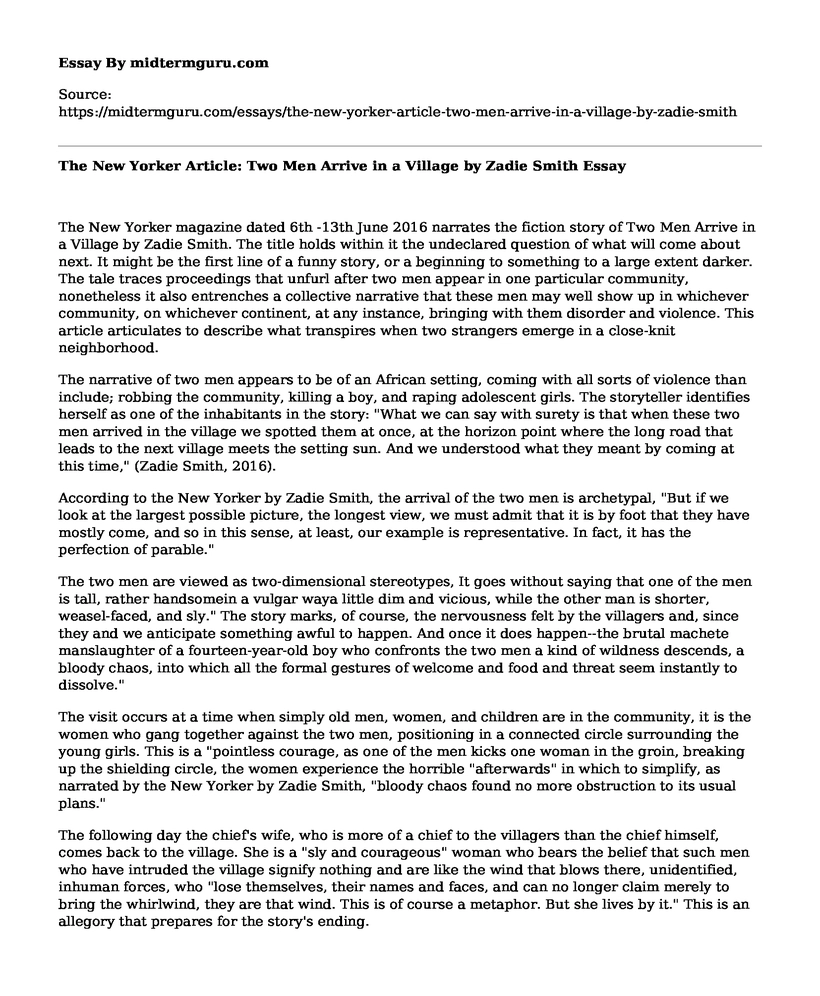The New Yorker magazine dated 6th -13th June 2016 narrates the fiction story of Two Men Arrive in a Village by Zadie Smith. The title holds within it the undeclared question of what will come about next. It might be the first line of a funny story, or a beginning to something to a large extent darker. The tale traces proceedings that unfurl after two men appear in one particular community, nonetheless it also entrenches a collective narrative that these men may well show up in whichever community, on whichever continent, at any instance, bringing with them disorder and violence. This article articulates to describe what transpires when two strangers emerge in a close-knit neighborhood.
The narrative of two men appears to be of an African setting, coming with all sorts of violence than include; robbing the community, killing a boy, and raping adolescent girls. The storyteller identifies herself as one of the inhabitants in the story: "What we can say with surety is that when these two men arrived in the village we spotted them at once, at the horizon point where the long road that leads to the next village meets the setting sun. And we understood what they meant by coming at this time," (Zadie Smith, 2016).
According to the New Yorker by Zadie Smith, the arrival of the two men is archetypal, "But if we look at the largest possible picture, the longest view, we must admit that it is by foot that they have mostly come, and so in this sense, at least, our example is representative. In fact, it has the perfection of parable."
The two men are viewed as two-dimensional stereotypes, It goes without saying that one of the men is tall, rather handsomein a vulgar waya little dim and vicious, while the other man is shorter, weasel-faced, and sly." The story marks, of course, the nervousness felt by the villagers and, since they and we anticipate something awful to happen. And once it does happen--the brutal machete manslaughter of a fourteen-year-old boy who confronts the two men a kind of wildness descends, a bloody chaos, into which all the formal gestures of welcome and food and threat seem instantly to dissolve."
The visit occurs at a time when simply old men, women, and children are in the community, it is the women who gang together against the two men, positioning in a connected circle surrounding the young girls. This is a "pointless courage, as one of the men kicks one woman in the groin, breaking up the shielding circle, the women experience the horrible "afterwards" in which to simplify, as narrated by the New Yorker by Zadie Smith, "bloody chaos found no more obstruction to its usual plans."
The following day the chief's wife, who is more of a chief to the villagers than the chief himself, comes back to the village. She is a "sly and courageous" woman who bears the belief that such men who have intruded the village signify nothing and are like the wind that blows there, unidentified, inhuman forces, who "lose themselves, their names and faces, and can no longer claim merely to bring the whirlwind, they are that wind. This is of course a metaphor. But she lives by it." This is an allegory that prepares for the story's ending.
The New Yorker further states that, the chief's wife approaches the girls who have been brutally attacked and finds one who has the guts to narrate to her the whole story, the ending of which, is "the most strange." For the small, sly man has informed the girl he was an orphan who has experienced challenges like all men face and has witnessed horror and now desires only to have offsprings with this girl and reside so far away from villages and urban centers. The girl, astounded by the suggestion, says the little man wanted her to be familiar with his name. "He had no shame," she narrates to the chief's wife. He alleged he did not want to imagine that he had passed throughout my village, through my body, with nobody considerate of what he was called. It is almost certainly not his authentic name although he said his name was."And at this point, Zadie Smith the author makes this description an incorporated short fairy-tale with this sudden ending of the chief's wife refusing to pay concentration to the man's name.
"But the chief's wife stood up suddenly, left the room, and walked out into the yard." There are two grounds as to why the chief's wife leaves sooner than the young girl is able to acquaint with her the name of the short, young man who raped her. The chief's spouse does not wish for the rape case to be personalized, wants the nasty villain to remain that mysterious, anonymous awfulness that he is, wants no probable validation or explanation for the dreadfulness of the acts committed by the villain.
Reference
The New Yorker: Two Men Arrive In A Village, June 6 & 13 2016. By Zadie Smith. HYPERLINK "http://www.newyorker.com/magazine/2016/06/06/two-men-arrive-in-a-village-by-zadie-smith" http://www.newyorker.com/magazine/2016/06/06/two-men-arrive-in-a-village-by-zadie-smith
Cite this page
The New Yorker Article: Two Men Arrive in a Village by Zadie Smith. (2021, May 20). Retrieved from https://midtermguru.com/essays/the-new-yorker-article-two-men-arrive-in-a-village-by-zadie-smith
If you are the original author of this essay and no longer wish to have it published on the midtermguru.com website, please click below to request its removal:
- Essay on Song of Myself by Walt Whitman
- Essay on the Three Character Traits of Courage, Love, and Hate Exhibited by Oedipus
- Analysis of Role of Directors in French and Italian Films - Paper Example
- Film Analysis Essay on Wings of Desire by Wim Wenders
- Literary Analysis of Kate Chopin's "The Story of An Hour"
- Film Analysis Essay on Moonlight
- Movie Analysis Essay on Tell Them We Are Rising







